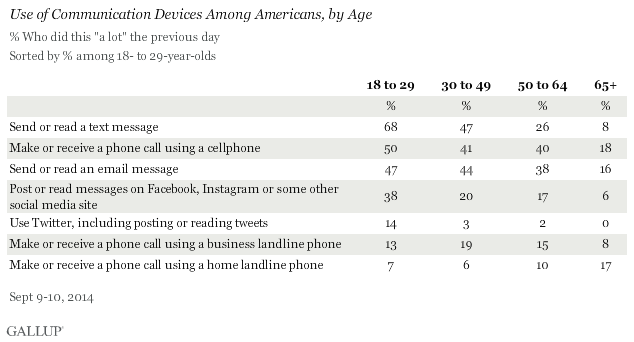By Glynn Wilson –
Texting, using a cellphone and sending and reading email messages are the most frequently used forms of nonpersonal communication for adult Americans topping home phones and Twitter by far, according to the latest Gallup poll on the subject.
Between 37 percent and 39 percent of all Americans said they used each of these technologies “a lot,” compared to only 10 percent of the population who say they still use a home landline phone or Twitter.
The ways Americans communicate vary significantly by age. Sending and receiving text messages is the most prevalent form of communication for Americans younger than 50. More than two-thirds of 18- to 29-year-olds say they sent and received text messages “a lot” the previous day, as did nearly half of Americans between 30 and 49.
Younger Americans are also well above average in their use of cellphones, email and social media on a daily basis.
Among Americans aged 65 and older, the most-used methods of communication are cellphones, landline phones and email, although this older group is generally much less likely than those who are younger to use any form of communication.
These results are based on a survey Gallup conducted Sept. 9-10, in which Americans were asked to say how frequently they used each of seven modes of communication “yesterday.” The survey’s interviewing days were Tuesday and Wednesday, meaning respondents answered the questions in terms of weekday, not weekend, communication patterns. The survey did not ask Americans how often they communicated in person or by traditional letters.
“These data clearly show that staying in touch with others using most of these forms of communication is an inverse function of age,” Gallup says. “There are no historical trends on these measures, so it is not possible to measure how much more likely young people were to communicate using whatever means were available in decades past.”
But in the present era, the percentage of 18- to 29-year-olds who used the seven methods “a lot” the previous day averages 34 percent, and that percentage drops to 26 percent among those aged 30 to 49, 21 percent among those aged 50 to 64, and down to 10 percent among those aged 65 and older.
Texting is the most frequently used form of communication among Americans younger than 50. Texting drops off significantly after age 50, and is used infrequently among those aged 65 and older.
Use of cellphones and email to communicate is highest among the youngest age group, with little dropoff among those 30 to 64, and is lowest among those aged 65 and older.
“Still, despite seniors’ relatively infrequent use of cellphones and email, both are essentially tied with landline phone use as the most frequently used method of communication even in this oldest age group,” Gallup finds.
The use of social media to communicate is in the top four among those aged 18 to 29, but its use drops off significantly among those 30 or older.
Few Americans of any age report using Twitter frequently, although its use is higher among the younger group. Three percent or less of those aged 30 and older report using Twitter a lot, including virtually no Americans aged 65 and older.
The use of home landline phones shows a different pattern by age than the other communication methods: it is low across all age groups, albeit slightly higher among those 65 and older. Business landline use is slightly lower among seniors.
Bottom Line
“One of the most striking cultural and social changes in the U.S. in recent decades has been the revolution in the ways Americans communicate. Until recently, humans were confined to communicating face to face and through letters and the traditional landline phone,” Gallup concludes. “Now, computer and smartphone use has dramatically accelerated, and texting, cellphones and email are the most commonly used modes of communication out of seven tested in this research. The use of social media is fourth.”
The younger the American, Gallup says, the more likely he or she is to communicate using these newer technologies, meaning millennials today are a generation that is highly “in touch” with their friends and relatives.
“It is possible that older Americans make up for their lack of use of these modes of communication by talking to others in person, or perhaps by traditional mail, but seniors’ low relative use of even the landline phone suggests they are basically less likely than those who are younger to be in touch with others on a daily basis,” Gallup says.
Part of the higher level of communication among young Americans could reflect lifestyle considerations, particularly their higher probability of being unmarried. It is also possible that younger Americans have simply been the quickest to embrace the communication capabilities that new technology represents, and that use of such technology will increase in older age cohorts as the millennials age in the years ahead.
Although the use of email and these other forms of communication could be considered a positive way for more physically isolated older Americans to stay in touch with others, these results suggest that use of these devices is not yet extremely common among seniors. That could reflect their lack of access to tools such as computers, tablets or smartphones to send and receive email or text messages, because they simply are less accustomed to using these forms of communication, Gallup says.
Survey Methods
Results for this Gallup poll are based on telephone interviews conducted Sept. 9-10, 2014, with a random sample of 1,015 adults, aged 18 and older, living in all 50 U.S. states and the District of Columbia. For results based on the total sample of national adults, the margin of sampling error is plus or minus 4 percentage points at the 95 percent confidence level.















